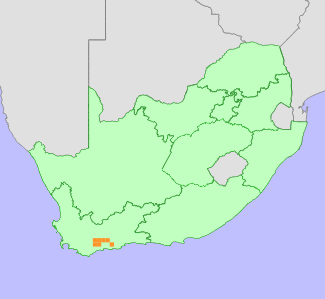|
Scientific Name | Cyclopia sessiliflora Eckl. & Zeyh. |
Higher Classification | Dicotyledons |
Family | FABACEAE |
Synonyms | Cyclopia brachypoda Benth., Cyclopia brachypoda Hofmeyr & E.Phillips (in part), Cyclopia vogelii Harv. (in part), Cyclopia vogelii Harv. var. brachypoda Harv., Rafnia retroflexa Thunb. var. b. Thunb. ex Kies |
Common Names | Heidelbergtee (a) |
National Status |
Status and Criteria | Near Threatened B1ab(iii,v)+2ab(iii,v) |
Assessment Date | 2022/10/26 |
Assessor(s) | D. Raimondo & N.N. Mhlongo |
Justification | This species has a limited distribution and has an extent of occurrence (EOO) of 2 013 km² and an area of occupancy (AOO) of 148 km². It is one of the top five species used for honey bush tea, and is currently declining due to over-harvesting. It is known from at least 25 locations but the area in which it occurs is heavily infested with invasive alien species. It therefore qualifies as Near Threatened under criterion B. |
Distribution |
Endemism | South African endemic |
Provincial distribution | Western Cape |
Range | This species is endemic to the Western Cape Province of South Africa, where it occurs in the Langeberg Mountains and Warmwatersberg. |
Habitat and Ecology |
Major system | Terrestrial |
Major habitats | South Langeberg Sandstone Fynbos, North Langeberg Sandstone Fynbos, Swellendam Silcrete Fynbos |
Description | Plants grow in well-drained, loamy, sandy soils, from 3 00-1 500 m.a.s.l. It resprouts from a woody rootstock after fire or harvesting. |
Threats |
| It was previously threatened by over-harvesting for the honey bush tea industry. There has been a long term trade in honeybush but the honeybush tea industry has slowly declined since 2012 and the volumes exported have dropped drastically from 300 tons to only 100 tons exported in 2021 (Gerrie Ferreira, pers. comm 2022). About 16% of its habitat has been transformed due to agricultural and urban expansion (calculated using GIS). The species' habitat is also heavily infested with invasive alien species. |
Population |
No population data is available for this species. However, it is suspected to be declining due to unsustainable harvesting for the honey bush tea trade. Competition with invasive alien species may potentially result in an additional population declines.
|
Population trend | Decreasing |
Notes |
| A species that resprouts from a woody rootstock after fire or harvesting. |
Assessment History |
Taxon assessed |
Status and Criteria |
Citation/Red List version | | Cyclopia sessiliflora Eckl. & Zeyh. | Least Concern | Raimondo et al. (2009) | |
Bibliography |
Kemp, M. 1985. Focus on Encephalartos caffer. Encephalartos 3:6-11.
Kies, P. 1951. Revision of the genus Cyclopia and notes on some other sources of bush tea. Bothalia 6:161-176.
Manning, J.C. and Goldblatt, P. 2012. Plants of the Greater Cape Floristic Region 1: The Core Cape Flora. Strelitzia 29. South African National Biodiversity Institute, Pretoria.
Raimondo, D., von Staden, L., Foden, W., Victor, J.E., Helme, N.A., Turner, R.C., Kamundi, D.A. and Manyama, P.A. 2009. Red List of South African Plants. Strelitzia 25. South African National Biodiversity Institute, Pretoria.
Schutte, A.L. 1997. Systematics of the genus Cyclopia Vent. (Fabaceae, Podalyrieae). Edinburgh Journal of Botany 54(2):125-170.
Vlok, J. and Schutte-Vlok, A.L. 2010. Plants of the Klein Karoo. Umdaus Press, Hatfield.
|
Citation |
| Raimondo, D. & Mhlongo, N.N. 2022. Cyclopia sessiliflora Eckl. & Zeyh. National Assessment: Red List of South African Plants version . Accessed on 2025/08/21 |
 Comment on this assessment
Comment on this assessment

